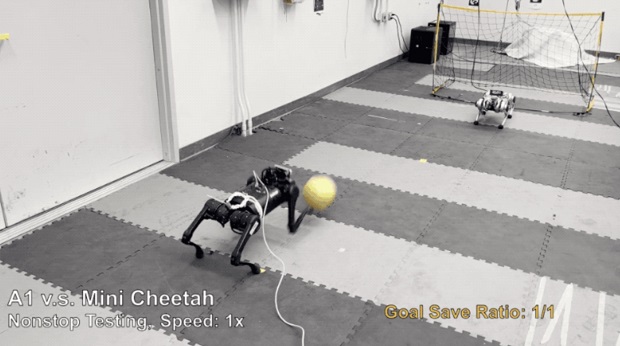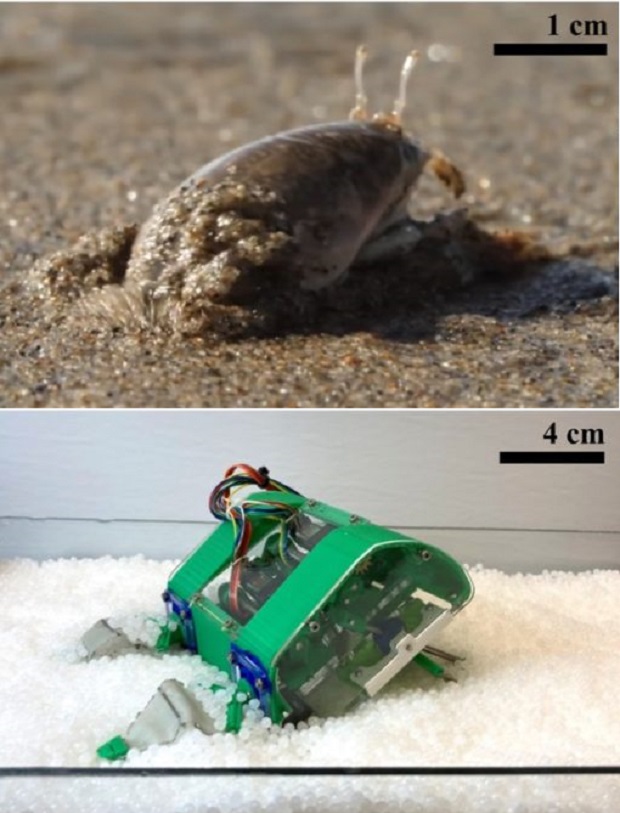
Robot goalkeeper and crab mole: Scientists create two interesting robots
Many groups of scientists are developing robots today, and some manage to achieve very, very impressive results. Recently, scientists at Cornell University created microscopic robots equipped with a rudimentary "brain" that allows them to move around autonomously.
Now another group of scientists has developed a goalkeeper robot that, like a goalkeeper in soccer, can detect an object flying at high speed and move to the right place to defend the goal.
Another team has developed a robotic crab that can bury itself in a loose medium.
Robot goalkeeper more effective than professional goalkeepers
Developed by scientists from the U.S. and Canada, the robotic goalkeeper Mini Cheetah was more effective than many professional goalkeepers in soccer. Goalkeepers in the English Premier League reflect about 80% of shots at goal, while Mini Cheetah repelled 87.5%.

The task of the robot was to detect a flying object in a fraction of a second, calculate its flight path and move to where it can defend the goal. The gate, by the way, was 1.5 meters wide and 0.9 meters high, and was hit from a distance of about 4 meters. Another Mini Cheetah robot or a human "played" against the robot, and in both cases it successfully repelled the attacks.
The robot could move horizontally to intercept the ball, but could also crouch and even jump. After a successful repulsion, it had to return to its starting position on four "legs" without losing its balance.
A sea crab that can bury itself in a loose medium
A new robot EMBUR (EMerita BUrrowing Robot) was created by scientists at the University of California, Berkeley, based on the analog of a sea crab. Like the Emerita analoga crab, the new robot can bury itself in a loose medium using its limbs.

The robot has four limbs with a retractable metal rod inside and fabric attached to it. "Joints" of the limbs are covered with a rubber membrane to keep the loose material from getting inside when the robot buries itself.
So, when the robot crab finds itself in a loose medium, its leg extends, the fabric attached to the rod is stretched and begins to pick up sand and move around in it.
Scientists say this robot could be used to assess soil composition in agriculture, as well as a variety of other applications. Since NASA also participated in the funding of this project, it can be assumed that such a robot could also be useful during the exploration of other planets.
- Related News
- Sparkles: Boston Dynamics unveils a furry robot dog that can dance (video)
- Chinese startup introduces robot that prepares, serves, pours wine, irons, and folds ironed clothes
- Flame-throwing robotic dog unleashed for sale in US: What will it be used for?
- Boston Dynamics introduces new version of Atlas robot that is completely electric։ Where will it be applied?
- Walker S humanoid robot receives Baidu's AI and learns to speak, reason and follow commands
- Humanoid robots will appear at Mercedes-Benz factories: What will they do?
- Most read
month
week
day
- Xiaomi unveils exclusive Redmi Note 13 Pro+ dedicated to Messi and Argentina national team 960
- Internet 500 times faster than 5G tested in Japan: It allows to transfer five movies in HD resolution in one second 813
- What will happen to the Earth if the Moon disappears? 738
- Which smartphones will be the first to receive Android 15? 729
- iPhone 16 may get colored matte glass back panel, 7 colors 715
- Great value for money: 3 best Realme smartphones 702
- WhatsApp receives two new features 660
- How do hackers use public Wi-Fi hotspots to intercept data and how to protect yourself from them? 626
- Why it is recommended to download applications on trusted platforms: In 2023, Google rejected publication of more than 2 million dangerous applications on Google Play 605
- Error in new version of WhatsApp: Users advised to uninstall latest version of messenger 582
- Archive
